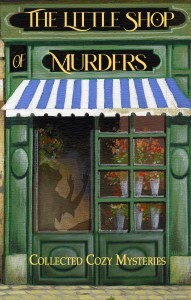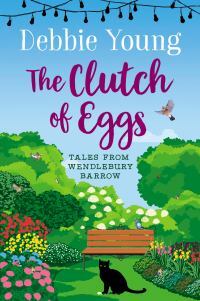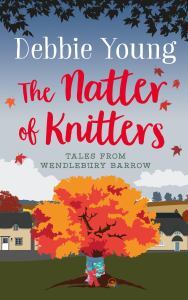Debbie Young's Blog, page 10
May 5, 2023
The Man with the Golden Spoon
My second post celebrating the Coronation of King Charles III, about the intriguing history of the Coronation Spoon, was originally written for the May issue of the Hawkesbury Parish News.
When we watch the Coronation of King Charles III, we’ll have a rare chance to see the Crown Jewels being put to practical use, rather than being ogled by tourists in the Tower of London. The Crown Jewels play a crucial and symbolic role in the thousand-year-old ceremony.
Unfortunately, the ones we shall see on 6th May are not quite that old, because on the abolition of the monarchy at the end of the English Civil War in 1649, Oliver Cromwell had the original Crown Jewels destroyed.
Ironically, he sent them to the Tower of London for this purpose. Only after the restoration of the monarchy in 1660 would the Tower of London serve to keep the Crown Jewels safe.
A modern republican might view Cromwell’s action as entirely justified. It certainly sounds in keeping with 21st-century environmental principles to make the most of the earth’s resources: reduce – reuse – recycle.
Reduce? Well, he had just beheaded Charles I.Reuse? He could skip that stage, assuming the monarchy had gone for ever.Recycle? Yes, that would do nicely. Thus he had the gemstones removed and sold, and the gold melted and reformed into coins stamped ‘Commonwealth of England’. Talk about adding insult to injury.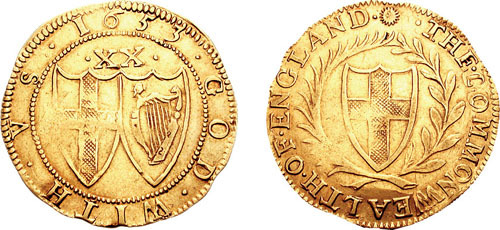 Perhaps these Commonwealth Coins had a previous incarnation as part of the original Crown Jewels? (Photo: Classical Numismatic Group, Inc. http://www.cngcoins.com – Creative Commons)
Perhaps these Commonwealth Coins had a previous incarnation as part of the original Crown Jewels? (Photo: Classical Numismatic Group, Inc. http://www.cngcoins.com – Creative Commons)Only one item from the original royal regalia survived unscathed: the golden Coronation Spoon. Although it may sound humble, it’s the most ancient, dating back to the twelfth century, and the most sacred, being used to anoint the sovereign with holy oil.
How did the spoon survive Cromwell’s otherwise comprehensive desecration of the Crown Jewels?
Clement Kynnersley, a court official who had cared for the late King’s wardrobe, had the remarkable foresight to buy it for sixteen shillings. The equivalent of 11 days labour for a skilled craftsman in those days, this must have seemed a lot to pay for a single piece of cutlery. But it was more affordable than a crown, orb or sceptre, and easier to conceal.
In short, it was a compact entry-level investment in royal regalia.
Perhaps Kynnersley was less optimistic than Cromwell about his future and saw the spoon as the ticket back to his old job if the Commonwealth crowd lost favour.
In any case, he didn’t melt the spoon down to make gold coins, but preserved it intact. After the restoration of the monarchy in 1660, he presented the spoon to the new King Charles II, who promptly gave him a job at court. Mission accomplished?
I’m rather taken with the pragmatic Clement Kynnersley, who puts me in mind of the character in the old folk song, The Vicar of Bray. I just hope that during the Interregnum he didn’t use his golden spoon to stir his tea or eat his breakfast boiled egg.
God Save the King’s Spoon!
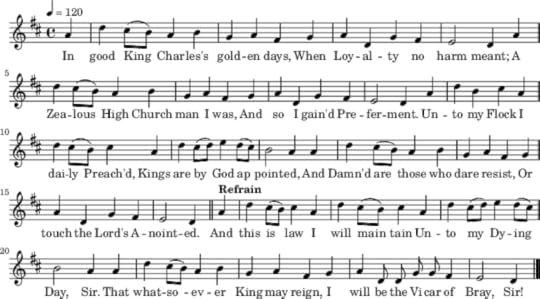
May 3, 2023
Crowning Glories
In anticipation of the Coronation of King Charles III, a post originally written for the Tetbury Advertiser, the magazine serving the community that includes Highgrove, the King’s country house in rural Gloucestershire
Anyone who has ever planned a celebratory event may sympathise with the Earl Marshal, the Duke of Norfolk, tasked with masterminding the Coronation ceremony on 6th May. It is only the second Coronation to be televised. If anything goes wrong, it will be witnessed by millions of armchair critics as well as those present in person.
Not least of the Earl Marshal’s worries must be protecting the Crown Jewels as they leave the safety of the Tower of London.
Over the centuries, the Tower’s Yeomen Warders have guarded these national treasures as effectively as any modern technology might do.
Only once did a would-be thief come close to stealing the Crown Jewels. During the reign of Charles II, security was rather less formal than today. The official Keeper of the Crown Jewels lived in an apartment over a basement where they were kept behind a grille. Although the Tower was not open to the public, anyone could pay the Keeper for a private view of the Crown Jewels.
 The audacious Colonel Thomas Blood, would-be thief of the Crown Jewels in 1671 (Portrait by G. Scott – Images Online, Public Domain, https://commons.wikimedia.org/w/index.php?curid=2079197)
The audacious Colonel Thomas Blood, would-be thief of the Crown Jewels in 1671 (Portrait by G. Scott – Images Online, Public Domain, https://commons.wikimedia.org/w/index.php?curid=2079197)In 1671, the Irishman Colonel Thomas Blood, dressed as a clergyman to exude an air of innocence, did just that. He quickly put the Keeper out of action by hitting him with a mallet, then flattened the crown for ease of transport. After stuffing the orb down his breeches – not such a master of disguise as he believed – he realised the sceptre was too big to fit in his bag, so one of his accomplices tried to cut it in half. Not surprisingly, Blood and his gang were apprehended before they could leave the Tower’s grounds.
The official punishment for this act of treason was to be hanged, drawn and quartered. Instead, Blood was pardoned by Charles II, who, bemused by the fellow’s nerve, granted him an estate worth £500 a year.
 The original rough Cullinan diamond, before it was cut to fit the Crown Jewels (public domain image via Wikipedia)
The original rough Cullinan diamond, before it was cut to fit the Crown Jewels (public domain image via Wikipedia)Equally audacious, but this time on the right side of the law, is the story of how in 1905 the world’s largest diamond, the Cullinan, a late addition to the Crown Jewels, was sent from South Africa to London. In the wake of the Boer Wars, the Transvaal government presented it as a conciliatory birthday gift to Edward VII.
In a bluff as bold as Blood’s, a replica of the huge gemstone was despatched from South Africa to London by ship, heavily guarded by detectives to suggest it was the real thing. Meanwhile the genuine article was packed into a plain box and sent by registered post, arriving safe and sound.
It was subsequently cut into smaller, more manageable parts. The largest piece, the heart-shaped Cullinan I, now tops the Sovereign’s Royal Sceptre, while the second largest, the Cullinan II, has been incorporated into the band of the Imperial State Crown.
 The “after” shot of the Cullinan diamond, repurposed, cut and polished to insert into the Crown Jewels (public domain photo via Wikipedia)
The “after” shot of the Cullinan diamond, repurposed, cut and polished to insert into the Crown Jewels (public domain photo via Wikipedia)I’m sure the Coronation will go brilliantly – this nation does these things so well – and I for one will enjoy it all the more for now knowing a little of the history of some of the King’s ceremonial accessories.
God Save the King – and the Crown Jewels!
April 19, 2023
For the Love of Telephone Box Libraries
Why I wrote a short story about a free community library in a telephone kiosk – a guest post and a radio interview
At the start of 2023, I made a promise to myself to share a new blog post every Wednesday, and I’m not going to allow Covid to stop me!
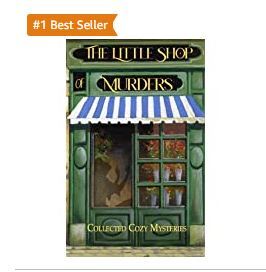 Thanks to a prescription for antivirals, I’m now testing negative and am on the mend, but I’m exhausted. So this week, my new post will be simply to share a link to a guest post I wrote as part of the launch publicity for the new charity anthology The Little Shop of Murders, in which each story is set in the high street, and a link to a BBC Radio Gloucestershire interview (expires 12th April 2023).
Thanks to a prescription for antivirals, I’m now testing negative and am on the mend, but I’m exhausted. So this week, my new post will be simply to share a link to a guest post I wrote as part of the launch publicity for the new charity anthology The Little Shop of Murders, in which each story is set in the high street, and a link to a BBC Radio Gloucestershire interview (expires 12th April 2023).
My contribution to this cosy mystery anthology is an exclusive short story about Sophie Sayers called Nowhere to Hide, set around the Wendlebury Barrow village phone box, which is being converted into a free community library.
Book Blog Guest PostClick here to read my guest post on the book blog Carla Loves to Read.
(My contribution appears towards the end of the Carla’s post – her summary and review of the book are at the top of the page, so keep scrolling to come to my twopennorth!)
BBC Gloucestershire Radio InterviewIf you’re in the UK, between now and Friday 12th April, you can also listen on BBC Sounds to a short interview I did about the anthology project with BBC Radio Gloucestershire presenter Dominic Cotter – fast forward to 2 hours and 39 minutes into the programme, which you can hear by clicking this link:
https://www.bbc.co.uk/sounds/play/p0fb1613.
Dom interviewed me down the line the day after I’d tested positive for Covid, and I’m sounding a bit croaky, but surprisingly perky considering how I was feeling at the time! Chatting to Dom is always a tonic!
The focus of the interview was Read for Good, the charity I’d nominated to benefit from the anthology, and which I wrote about in this post last week:
 Read for Good encourages children to read for pleasure and also sends new books and professional storytellers into children’s hospitals all over the UK
Read for Good encourages children to read for pleasure and also sends new books and professional storytellers into children’s hospitals all over the UKIf you’d like to read other short stories set in Wendlebury Barrow, there are two novelettes (about 20% of novel length), called The Clutch of Eggs and The Natter of Knitters, available to buy in ebook or as tiny, compact paperbacks.
Click the Links to Order Your Copies HereThe Little Shop of Murders * The Clutch of Eggs * The Natter of Knitters
April 12, 2023
Why I Nominated Read for Good to Benefit from a New Charity Anthology
This week, a post within a post, sharing my guest post about the children’s reading charity Read for Good, written as part of the marketing campaign for the new charity anthology, The Little Shop of Murders.
Late last year, I was pleased to be invited, along with fourteen other cozy mystery authors, to contribute a story for the new charity anthology, The Little Shop of Murders, and I had great fun writing a new Sophie Sayers short story especially for this project.
When the book was launched in paperback and ebook on 1st April, it went straight into the bestsellers list on Amazon UK, and for some time enjoyed the top rank in the Fiction Anthologies category.

As part of the marketing campaign for the new book, I volunteered to write two guest posts as part of its “blog tour” – a virtual launch event in which the book is featured on a succession of different book blogs. I chose two subjects: the first was on why I nominated Read for Good as the UK charity to benefit from the project, and the other on why I chose to focus my story on the popular phenomenon of Little Free Libraries, in particular on those based in repurposed public telephone kiosks.
The first of these has now been published on Dollycas’s blog, and the second is to follow shortly.
This week I’d like to share with you the first of these guest posts, my post about Read for Good, the charity for which I worked for three happy years, just before giving up “proper” jobs to focus on my writing.
Just click the link below to read my post.
IN OTHER NEWS
On Monday, I returned the edited manuscript of the fourth Gemma Lamb cozy mystery to my publisher, Boldwood Books, who will be launching Artful Antics at St Bride’s on 29th July. Cover reveal to follow soon!
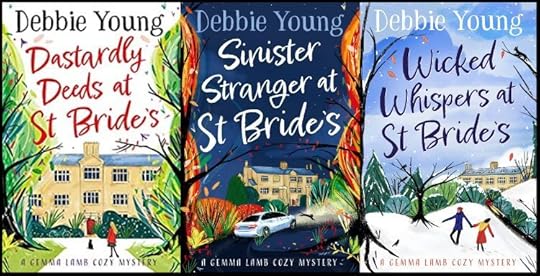 Gemma Lamb’s story so far… the first three in the series are now available in ebook, paperback, hardback, large print and audiobook!
Gemma Lamb’s story so far… the first three in the series are now available in ebook, paperback, hardback, large print and audiobook!In the meantime, I’m 15,000 words into the first draft of my next book, to be set in Cornwall – a standalone novel that will not be part of either the Gemma Lamb nor the Sophie Sayers series. The details are still under wraps at the moment, but I’ll share them when the project is nearing completion.
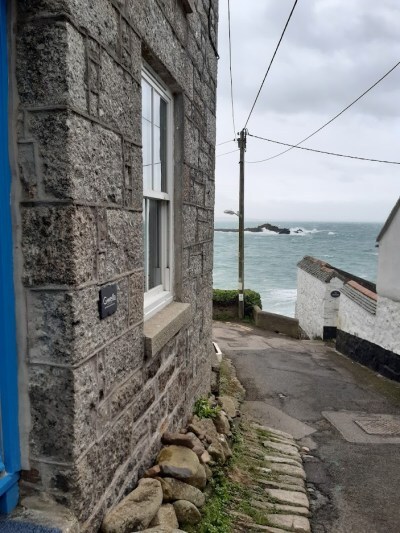 Gwella, the cottage in Mousehoule that inspired my work-in-progress
Gwella, the cottage in Mousehoule that inspired my work-in-progressOn Tuesday 18th April, I’ll be starting to teach my third course for Jericho Writers – more news about that here – https://jerichowriters.com/our-services/courses-mentoring/simply-self-publish-course/
Also on that day, one of my course alumni, S M Davies, will attend the Bookbrunch Selfies Awards ceremony in London, for which her debut self-published novel, The West Rises, has been shortlisted for this prestigious award, given for the best independently-published novels in the UK. (Two of my own novels have been shortlisted in previous years.) Read about the shortlist here.
Several other author friends, Jean Gill, Jane Davis and G D Harper, are also on the shortlist, so I have lots of people to root for! Although I now have three traditional publishing contracts, with Boldwood Books, Saga Egmont and D P Verlag, I continue to advocate for self-publishing as a valid and viable means for launching your books into the world.
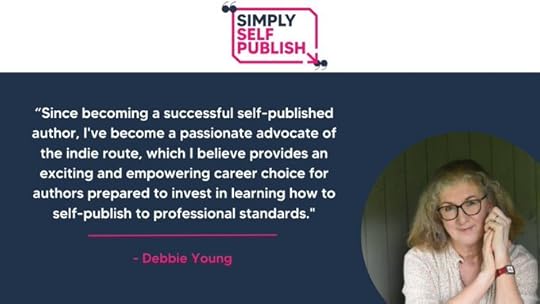
On Wednesday 19th April, I’ll be visiting the London Book Fair so if you’re planning to be there, perhaps we can meet! Just let me know if you’re also visiting that day.
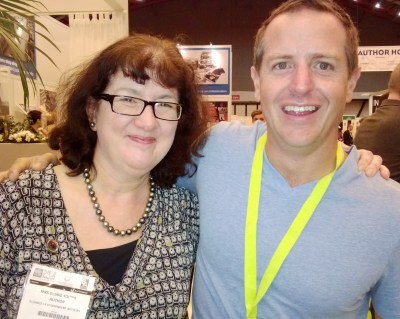 With indie author superstar Hugh Howey at the London Book Fair 2014, just after he’d congratulated on my speech about the non-fiction book I’d co-written for the Alliance of Independent Authors
With indie author superstar Hugh Howey at the London Book Fair 2014, just after he’d congratulated on my speech about the non-fiction book I’d co-written for the Alliance of Independent AuthorsOn Saturday, 22nd April, I’ll be chairing the next event in the Hawkesbury Upton Literature Festival, a Festival of Words at our local parish church of St Mary’s, Hawkesbury, in the Cotswolds. Tickets are still available for the day-long series of talks and readings, although the lunch is already sold out, but picnics are welcome! To book your day ticket, visit Eventbrite here: https://www.eventbrite.co.uk/e/hulf-talk-festival-of-words-tickets-529559034327
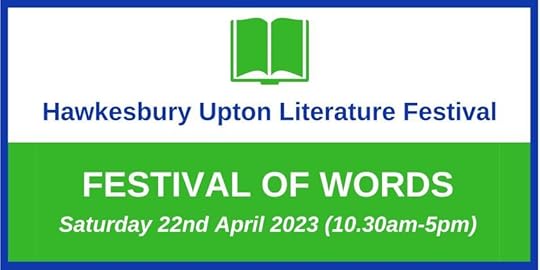
Once I’ve recovered from that little onslaught, I’ll start planning my next novel for Boldwood Books, Sophie Sayers’ ninth adventure, working title Driven to Murder, in which Sophie attempts to learn to drive, amid shady goings-on with the local bus service. This coincides with controversial changes to the real-life bus service in the Cotswold village where I’ve lived for over 30 years, so although, as ever, all my stories are completely fictitious, there’s no shortage of real-life inspiration around me!
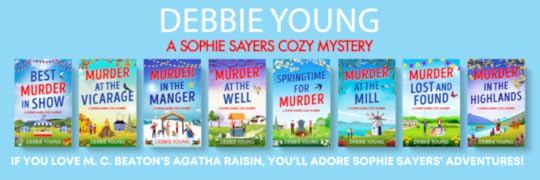 Sophie Sayers’ story so far…
Sophie Sayers’ story so far… Writing aside, I’m looking forward to “ringing for the King” to mark the celebrations of the coronation of King Charles III – and I plan to write a mystery story set around a parish church bell tower before long!
Writing aside, I’m looking forward to “ringing for the King” to mark the celebrations of the coronation of King Charles III – and I plan to write a mystery story set around a parish church bell tower before long!
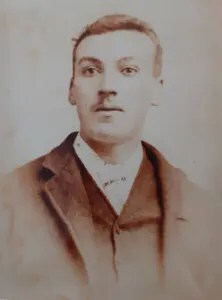 My great-grandfather, who rang for a different King in 1911
My great-grandfather, who rang for a different King in 1911Since posting last week on the topic of bell ringing (you can read that post here: https://authordebbieyoung.com/2023/04/05/ringing-for-the-king-and-me/), I’ve discovered that my great-grandfather rang for the King in 1911 – for the coronation of George V and Queen Mary! I’m thrilled to be continuing the family tradition. And now I must dash, because it’s bell ringing practice night!
April 5, 2023
Ringing for the King and Me
With only a few weeks to go until the King’s coronation, volunteers are still being sought to “Ring for the King”. Here’s why I’m glad to be a bell ringer.
In our digital age, church bells may no longer serve as news media, alerting locals to births, marriages, deaths – I learned of the Queen’s death on my DAB radio as I typed at my PC – but they still have the power to unite the nation.
Last September, ringing to mark the death of the monarch and the proclamation of the new one was a moving act of community and patriotism. It will be an honour to ring for the coronation in May.
The reasons I took up bell ringing have nothing to do with royalty…
Before I was born, my great-grandfather was a highly accomplished ringer, and I’d always wanted to learn in his honour.
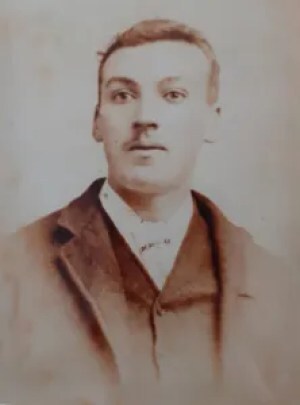 My great-grandfather, the bell ringer
My great-grandfather, the bell ringerIn my teens, reading Dorothy L Sayers’ mystery novel The Nine Tailors, set around the bell tower of an East Anglian fenland village church, informed and intrigued me about the practice. A few years ago, when my parish church acquired a new ring of eight bells, I determined to try my hand at last.
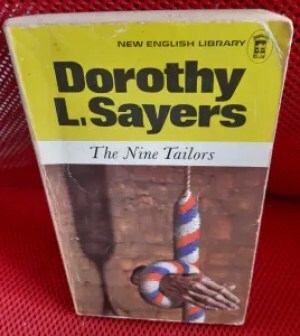 My treasured copy of Dorothy L Sayers’ The Nine Tailors, which I’ve read countless times since I bought this book in my teens
My treasured copy of Dorothy L Sayers’ The Nine Tailors, which I’ve read countless times since I bought this book in my teensLike most newcomers, I assumed bell ringing to be a simple process. I thought pulling a rope to elicit the desired effect would be like using the chain to flush an overhead toilet cistern.
I know now it’s a far subtler art. Learning to control a bell takes many hours of training, before you even start trying to ring in complex patterns as part of a band. And yes, band is the right word, because church bells are musical instruments.
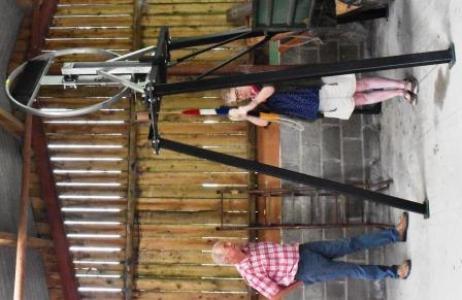 Learning the basics of bell ringing on the dumb bell, under the guidance of St Mary’s Tower Master Colin Dixon
Learning the basics of bell ringing on the dumb bell, under the guidance of St Mary’s Tower Master Colin DixonPerseverance pays off. Bell ringing is sociable and entertaining. It improves mental and physical agility, balance, muscle endurance and cardiovascular fitness. Whenever a fellow ringer arrives at a practice night complaining of backache, the rhythmic, gentle stretching involved in ringing a bell for an hour or so enables them at the end of the session to skip down the spiral stairs, pain-free. As a hobby, it costs nothing, and you don’t need special kit.
Why join a gym when you can be in a bell ringing band?
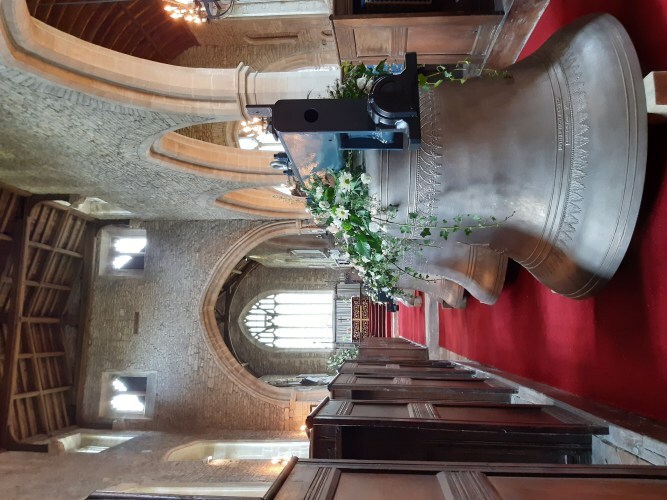 The new ring of eight bells arrives at St Mary’s, Hawkesbury two years ago – now out of sight in the bell tower
The new ring of eight bells arrives at St Mary’s, Hawkesbury two years ago – now out of sight in the bell towerBut be warned: if you take up bell ringing to Ring for the King, you’ll likely find yourself hooked long after 6th May. Bell ringing is for life, not just for coronations, which is just as well, considering coronations don’t happen very often. We’re unlikely to have to wait another 70 years for the next one, but our Royal Family has form on longevity, which is good news all round. You should have plenty of time to perfect your bell ringing technique for the next one.
This post was originally written for the Tetbury Advertiser‘s April 2023 edition.
 LIKE TO GIVE BELL RINGING A TRY?
LIKE TO GIVE BELL RINGING A TRY?
Then come along to the next Hawkesbury Upton Literature Festival event at St Mary’s Hawkesbury on Saturday 22nd April, where Tower Captain Colin Dixon will give a talk on the language of bells. The bells will be ringing to mark this special occasion, and the bell tower will be open for tours and taster sessions.Visit www.hulitfest.com for more information, or book via Eventbrite here:
https://www.eventbrite.co.uk/e/hulf-talk-festival-of-words-tickets-529559034327
 Sample bell ringing at the next HU Lit Fest event at St Mary’s Hawkesbury (Photo by Ian Macfadyen)
Sample bell ringing at the next HU Lit Fest event at St Mary’s Hawkesbury (Photo by Ian Macfadyen)
IN OTHER NEWS
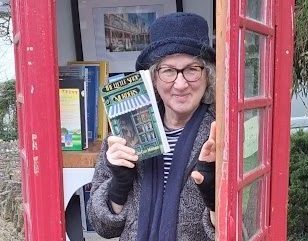 I’m pleased to report a very successful launch of the new charity anthology, The Little Shop of Murders, for which I wrote a new, exclusive Sophie Sayers Cozy Mystery short story, set around a community library in a red telephone kiosk.
I’m pleased to report a very successful launch of the new charity anthology, The Little Shop of Murders, for which I wrote a new, exclusive Sophie Sayers Cozy Mystery short story, set around a community library in a red telephone kiosk.
It has been riding high in the Amazon Kindle charts, the #1 Bestseller in various categories including Fiction Anthologies, which is great news for the three charities to whom all profits are going!
 The book is also available in a beautiful glossy paperback, which I’m seen clutching here in the phone box library in Horton, the next village to mine.
The book is also available in a beautiful glossy paperback, which I’m seen clutching here in the phone box library in Horton, the next village to mine.
For more information about this lovely joint venture with 14 other mystery writers, plus details of the three children’s charities that it’s supporting, read my pre-launch post here:
https://authordebbieyoung.com/2023/02/15/the-little-shop-of-murders/
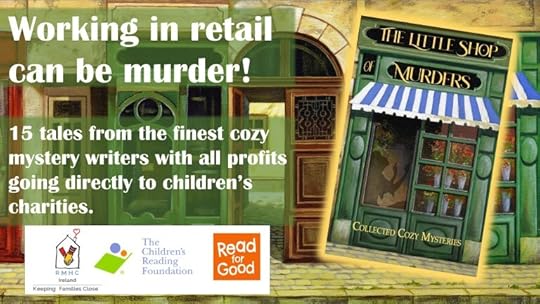
March 29, 2023
What Did the Romans do for Readers?
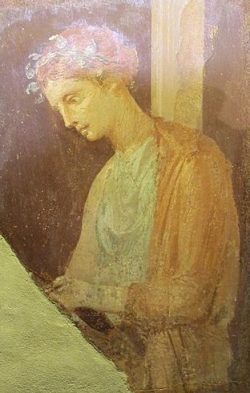 Young woman reading in Pompeii
Young woman reading in PompeiiRound about World Book Day, I discovered my author friend Alison Morton was about to launch a special tenth-anniversary hardback edition of her debut novel Inceptio, inspired by her love of ancient Rome, and previously published in paperback, ebook and audiobook.
That got me thinking about what formats Ancient Romans used to read – books? scrolls? tablets? (the wax type, not the digital ones). Intrigued, I asked Roman expert Alison to enlighten me, and this post is the result.
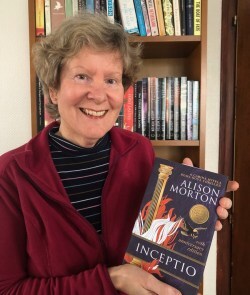 Alison Morton celebrates the tenth anniversary of her debut novel Inceptio with a special hardback edition
Alison Morton celebrates the tenth anniversary of her debut novel Inceptio with a special hardback editionBut first, a little background…
Inceptio is the start of a long series of alternative history thrillers set in Roma Nova. Roma Nova is an imaginary country in Europe, a remnant of the Roman Empire that’s survived into the present and prospered due to its tenacity, engineering know-how and robust attitude. Out of necessity, sisters and daughters had to take up arms alongside men to help defend their fledgling state in the late 4th century. The descendants of these tough and capable women rule Roma Nova today. Eight contemporary thrillers tell of transformation, deception, rebellion, vengeance takers, comradeship and epic love stories. Inceptio introduces Carina, the first of these 21st century heroines.
The Interview Starts Here…Debbie: Alison, welcome to my blog! I’m delighted to be able to share your expert knowledge of ancient Roman reading habits. N ow, w hen I think of reading Latin words, I picture stone tablets on which inscriptions are engraved. What other formats did the Romans use to share the written word?
Alison: Everyday writing (accounting, notes) and for teaching writing to children could be done with a pointed stylus on wood-framed wax tablets. The beauty was that mistakes could easily be corrected or erased by using the spatula or spherical shaped end of the stylus. Several of these tablets could be laced together into a codex. Indeed, the word codex means block of wood.
Wax tablets were also used for official documents such as birth certificates or military diplomas giving rights to veteran legionnaires as well as administrative purposes requiring a certain durability and verifiability of the document. One was found still covered with wax at Pompeii.
The Vindolanda messages written on thin pieces of wood are other examples of informal writing mostly about dinner parties and bar bills.
Some documents, and later legal contracts, and books in the form of scrolls were written in pen and ink on papyrus. Use of parchment or its finer version, vellum, eventually overtook papyrus for shorter documents but the latter was still used especially for book scrolls where available.
Codices made of sheets of vellum, papyrus, or other materials gradually replaced the scroll. This change has been called the most important advance in book making before the invention of the printing press.
According to Suetonius, Julius Caesar may have been the first Roman to reduce scrolls to bound pages in the form of a notebook, possibly even as a papyrus codex. The poet Martial mentions the convenience with which such a book can be read on a journey. By the end of the fourth century, codices had almost completely replaced scrolls as the most common format for written material.
Debbie: Why did they write in a continuous line of letters in upper case with no punctuation? Did it make it more challenging to read?
 Not a lower case letter in sight
Not a lower case letter in sightAlison: The interpoint (interpunctus) was used in classical Latin to separate words. Apart from the round form, inscriptions sometimes used a small equilateral triangle, pointing either up or down. The interpoint fell out of use c. AD 200. Latin was then written in scripta continua – with no spaces or punctuation – for several centuries.
Only by knowing the case endings could you hope to read it with any hope of working out the meaning!
Latin was often written down by slave scribes whose role was simply to record everything they heard to create documentation. Because speech is continuous, there was no need to add spaces. Spaces began to be added around the 7th/8th century and by 13th/14th century, most modern European texts contained spaces.
Inscriptions on Roman tombs, arches, buildings and coins that we see today were always in capitals. Lowercase letters developed from cursive versions of these capitals. Old Roman cursive script was the everyday form for writing letters (including love letters and dinner invitations), by merchants writing business accounts, and for any quicker, informal writing. Commonly used from about the 1st century BC to the 3rd century, but it had probably existed earlier. New Roman cursive was in use from the 3rd century to the 7th century with letter forms more recognisable to modern eyes – a, b, d and e had taken a more familiar shape.
 NB The Romans used fewer letters than we did
NB The Romans used fewer letters than we did
Debbie: How many Ancient Romans could read and how did they learn?
Alison: This is a difficult one to pin down. Estimates of the literacy rate in the Empire range from 5% to at least 30%. The state did not provide education so formal education was available only to children from families who could pay for it. For those who did learn, school would be held regularly in a rented space, or in any available public niche, even outdoors. Both boys and girls did receive primary education between ages 7 and 12, but classes were not segregated by grade or age.
Debbie: Were girls and women taught to read too?
Alison: Although some images from Pompeii show women with scrolls, their poses depict them as muses rather than writers. However, some women did write: a Roman relief shows a female bookkeeper working in a butcher’s shop, and writing materials were found in women’s graves almost as frequently as in men’s.
Debbie:
Was reading the same popular hobby it is today? What place did reading have in social life?
Alison: Books were expensive, since each copy had to be written individually on a roll of papyrus (volumen) by specialist scribes.
Commercial production of books had been established by the late Republic and by the first century AD certain neighbourhoods in Rome were known for their bookshops (tabernae librariae).
Collectors amassed personal libraries and individual benefactors might endow a community with a library. Pliny the Younger gave the city of Comum a library valued at 1 million sesterces, along with another 100,000 to maintain it. Most major cities in the Roman Empire had public libraries including the famous one in Ephesus.
Ever the opportunist, G. Julius Caesar established books as status symbols. By AD 377 Rome had twenty-eight large libraries where citizens could go and read books free of charge.
 The facade of an ancient Roman library at Ephesus Celsus
The facade of an ancient Roman library at Ephesus CelsusDebbie: To what extent did functional literacy aid the expansion and success of the Roman Empire?
Alison: The military needed a vast number of written reports and service records, thus literacy in the army was strikingly high. Widespread urban graffiti, ranging from literary quotations to filthy jokes with misspellings show a basic but general level of literacy. Numeracy was also necessary for any form of commerce from small business to large state enterprises. Slaves were numerate and literate in significant numbers, and some were highly educated.
Latin became the language of conquered areas not because the population was displaced by Latin-speakers nor because was Latin imposed officially.
Local people started speaking Latin out of self-interest as it was the language of government, the Imperial service, and required for any form of advancement.
Debbie: Apart from functional texts such as for legal and political documents, what did the Romans like to read for pleasure?
Alison: Literary texts – plays, poetry, stories, histories – were often shared aloud at meals or with reading groups. Scholars such as Pliny the Elder had works read to them also while they bathed or travelled, times during which they might also dictate drafts or notes to their secretaries.
The reading public expanded from the 1st to the 3rd century, and while those who read for pleasure remained a minority, it was no longer confined to a sophisticated ruling elite.
Illustrated books, including erotica, were popular, but there are very few surviving fragments.
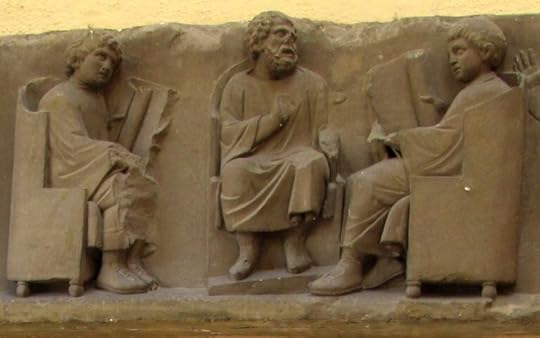
Debbie: Was there any censorship?
Alison: Very much so! To maintain tight control over what people read, government officials selected what appeared on library shelves. Books were seen as dangerous because they spread ideas. At the extreme, the punishment for writing something libellous was death.
The writer Juvenal advised that before you criticised somebody the best thing to do was to wait until they died.
Historians were viewed as being particularly subversive.
Emperor Domitian disapproved of books written by the historian Hermogenes of Tarsus and had him executed. As well as ordering the destruction of all the author’s books, Domitian also had all the copyist slaves killed.
Debbie: The Romans never had the printing press, but how did they influence later developments in reading and writing?
Alison: For printing to prosper, you would need paper, stable ink, a screw press, a system for creating precise matrices and casting lead type, and a system to lock the type. None of these technological tools were developed by the Romans.
But Romans transmitted the discipline of collecting and processing information, the idea of recording and formalising law, they gave Europe a lingua franca, along with a systemic creative framework and a love of reading its output and, of course, the clear Roman type we all know today.
Alison’s afternote: All my heroines read, whether it’s Julia’s love of 4 th century poetry, Carina and her movie magazine or Aurelia and her novels.
Debbie: Alison, thank you so much for enlightening us about what the Romans did for reading. Let’s finish by sharing more information about you as an author and about this special 10th anniversary edition of Inceptio.
More about Alison Morton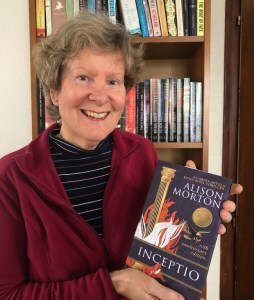 Alison Morton celebrates the tenth anniversary of her debut novel Inceptio with a special hardback edition
Alison Morton celebrates the tenth anniversary of her debut novel Inceptio with a special hardback editionAlison Morton writes award-winning thrillers featuring tough but compassionate heroines. She blends her fascination for Ancient Rome with six years’ military service and a life of reading historical, crime and thriller fiction. On the way, she collected a BA in modern languages and an MA in history.
Her ten-book Roma Nova series is set in an imaginary European country where a remnant of the ancient Roman Empire has survived into the 21st century and is ruled by women who face conspiracy, revolution and heartache but with a sharp line in dialogue. Inceptio starts the adventure.
Her most recent novel, Julia Prima, is a more traditional historical novel, set in the fourth century AD. Alison lives in Poitou in France, the home of Mélisende, the heroine of her two contemporary thrillers, Double Identity and Double Pursuit.
To find out more about Alison Morton and her books, visit her website: https://alison-morton.com, where you’ll also find all her social media links and a sign-up form for her monthly e-newsletter.

“It’s about Roman blood, survival and money. Mostly yours.”
In an alternative New York, Karen Brown is running for her life. She makes a snap decision to flee to Roma Nova – her dead mother’s homeland, the last remnant of the Roman Empire in the 21st century. But can Karen tough it out in such an alien culture? And with a crazy killer determined to terminate her for a very personal reason?
Stifled by the protective cocoon of her Roma Novan family, deceived by her new lover, she propels herself into a dangerous mission. But then the killer sets a trap – she must sacrifice herself for another – and she sees no escape.
A thriller laced with romance and coming of age, this first in series is Roman fiction brought into the 21st century through the lens of alternative history and driven by a female protagonist with heart and courage.
This 10thAnniversary hardback edition includes bonus content: Three character ‘conversations’, two short stories and the story behind INCEPTIO.
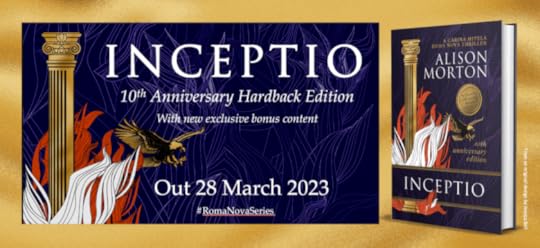
March 22, 2023
Celebrating Words at Hawkesbury Upton Literature Festival
“Hello, Debbie, how are you? Busy with – whatever it is you do?”
This greeting from a neighbour the other day made me smile. It’s true that I do a lot of different things besides writing books, and even I have trouble keeping up with myself sometimes.
So I thought it might be a good idea to start sharing on my blog some of my various activities, just in case anyone else is wondering how I fill my days.
This week, I’m going to tell you about the Hawkesbury Upton Literature Festival, which I founded in 2015 as an affordable, accessible and fun bookish event for my village.
HULF in a NutshellHULF, as we call it for short, has taken various forms over the years, starting out as an evening in the pub, rapidly growing into a huge all-day event in multiple venues, with four or five different events starting on the hour every hour between 10am and 5pm, before being put on hold during Covid lockdowns.
 From the last HULF before lockdown intervened (Photo by Angela Fitch)
From the last HULF before lockdown intervened (Photo by Angela Fitch)Post-lockdown, I’ve revived it on a smaller and more manageable scale, bringing together a handful of authors and other guest speakers in a single venue to talk on a particular theme for an afternoon. In April 2023, I’ll be scaling it back up again to a full-day event, but still in a single venue.
Cook’s Perks for Festival OrganisersWhen I was a child, my maternal grandmother, who worked as a cook for a military officer, taught me a great phrase: “cook’s perks” – the secret bonuses of the job, such as getting to lick the spoon after you’ve finished spreading the icing on a cake.
That phrase still goes through my head not only when I’m cooking, but also when I’m planning the programme for the Hawkesbury Upton Literature Festival, because I get to pick the topics that I want to hear more about. Of course, I choose subjects and speakers to attract and please an audience, but I confess the first audience I think about is myself.
A Celebration of WordsI decided in December, when I was outlining the schedule of talks for the new year, that the next HULF event would focus not on a particular genre or theme of literature, but on the English language.
I wanted to hear about different aspects of language and writing in general, and I set about booking speakers with special knowledge of and expertise in words and ways of using language, from how the English language was formed and how words get into the dictionary, to specialist applications of language such as codes and lyrics.
The following programme is the result of my curiosity, and the HULF Festival of Words will take place on Saturday 22nd April (10.3-5pm).
The TalksThe Language of Bells – with a demonstration of bell ringing, a short talk, and readings of related poetry and proseJargon in Fiction – the language of pugilism in novels from Dickens to the present dayCracking Codes & Made-up Languages – the Enigma Machine, the Colditz Code, Jabberwocky & Other NonsenseThe Secret Life of Ghostwriters – putting words in other people’s mouthsHow New Words Are Chosen for the Dictionary – by a professional lexicographer from the Oxford English DictionayHow William Tyndale Still Affects the English Language Today – just as much as Shakespeare, apparently!On Translation – with readings from Brian Friel’s play of the same nameFitting Words to Music – a discussion of lyrics with St Mary’s Music Director and ChoirmasterAncient vs Modern English:– in Historical Fiction: Gadzookery or Ok?
– in the Church of England: an interview with two vicarsLanguage versus Meaning in the Old Testament – putting the Bible into historical contextSumming Up: The Art of the AphorismWords on Paper: A Calligraphy Exhibition
The event kicks off at 10.30am, with a lunch break from 1-2pm (more of that in a moment), and at 5pm we’ll close with Prospero’s wonderful speech: “Our revels now are ended…”.
The SpeakersAnother perk of being Festival director is that I get to choose the speakers – all people who I know will do an excellent job. For the HULF Festival of Words I have assembled a cast of really interesting mix of experience and perspective:
Gerard Boyce – retired English teacher and brilliant reader of prose and poetry Lucienne Boyce – author of historical fiction and non-fiction Colin Dixon – Tower Captain of St Mary’s Hawkesbury Bell Ringers Bill Fairney – author of fiction and non-fiction, including a novel about the Enigma machine Ben Humphries – musician, composer and music director for the Badminton Benefice Jennifer Hurd – lexicographer at the Oxford English DicitionaryJohn Lynch – author of fiction and non-fiction and professional ghostwriterIan Macfadyen – retired Air Marshall and churchwarden of St Mary’s HawkesburyMichael Macmahon – author of Brevity is the Soul of Wit and professional voice artistLisa Overton – historian and churchwarden of St Mary’s Hawkesbury Tina Stubbs – author of Disowning the Violence: Challenging the Disturbing Image of God in the Old Testament Rev Trevor Stubbs – retired vicar and missionary, and fiction authorRev Richard Thomson – vicar of St Mary’s Hawkesbury and Badminton BeneficeThe VenueChoosing the venue is another privilege that I enjoy, and I like to use the festival events to draw attention to village venues that will benefit from the income and exposure. This time, the venue will be St Mary the Virgin, Hawkesbury GL9 IBN, our beautiful ancient parish church that pre-dates the Domesday Book. St Mary’s is situated just down the hill from the centre of Hawkesbury Upton, in a peaceful, timeless hamlet.
I’m a member of the Friends of St Mary’s, which exists to maintain this beautiful part of our local heritage for the enjoyment of present and future generations. I hope that by staging a HULF event at St Mary’s, we’ll draw more attention to this hidden gem, attract more visitors, and raise much-needed funds. All the profits from this HULF Talk will go to the Friend’s of St Mary’s.
 (Photo by Ian Macfadyen)Options for Lunch
(Photo by Ian Macfadyen)Options for LunchKnowing that not much happens in Hawkesbury Upton without cake, I’ve made tea, coffee, cake and biscuits a regular feature of HULF. The £5 per person admission ticket for HULF Talks include copious refreshments.
As this is an all-day event, there will be an hour’s break for lunch, and you’re welcome to bring picnics and packed lunches to enjoy in the church and its beautiful grounds.
As an extra fundraiser, and for added enjoyment, this time there will be an optional sit-down lunch of home-made quiche, salad, and fruit, served in the historic setting of the ancient Malthouse opposite the church, by kind courtesy of Lisa and Christopher Overton. Due to limited space, this lunch is only bookable in advance for £10 per head. Wine and soft drinks will be available to buy on the day for a small extra charge. You must have an event ticket to be able to attend the lunch.
Like to Join Us?I hope that explanation of my involvement with HULF may have whetted your appetite to attend, provided of course you live within reach of our idyllic corner of the Cotswolds. If so:
BOOK YOUR TICKETS FOR THE EVENT AND FOR THE LUNCH HERE!
For more information about HULF, please visit www.hulitfest.com . If you’d like to keep informed about future HULF events, please join the HULF mailing list via the website.
Now, back to whatever is next on my list of things to do. Ah yes, to cook tea for my husband and me. Cook’s perks, here I come again!
In Other NewsMy latest novel, Murder in the Highlands , has been on a whirlwind tour of bookbloggers, picking up some terrific reviews.A new charity anthology, The Little Shop of Murders , featuring an all-new Sophie Sayers short story, is now available to buy in paperback, and the ebook launches on 1st April. Artful Antics , my fourth Gemma Lamb mystery, set at St Bride’s School, is about to go into production with my publisher Boldwood Books.I’ve just returned from a week’s writing retreat in Cornwall, where I planned a completely new book – but I’m keeping that under wraps for now!
March 15, 2023
Introducing Sophie Sayers’ Brand New Scottish Adventure
Today I’m delighted to share with you the launch of my latest novel – the eighth Sophie Sayers Cozy Mystery and the first all-new one for some time!
Murder in the Highlands picks up where Murder Lost and Found left off, at the end of Sophie’s first year in her adopted Cotswold home of Wendlebury Barrow. Both Sophie and Hector have grown during the course of the year, and their relationship feels settled. So now it’s time for Sophie to take Hector to meet her parents in Inverness – the first time they’ve been beyond the village together other than for day trips, and their first shared holiday.
 This is the kind of place I imagine Sophie’s parents living, on the banks of the River Ness
This is the kind of place I imagine Sophie’s parents living, on the banks of the River NessSophie, conscious of her parents’ foibles, is nervous of introducing them to Hector, but she also wants them to approve of him. She’s soon distracted from such matters when it emerges that a murderous stranger is on their tail, turning what was meant to be a relaxing break into a nerve-wracking race about Inverness and the Scottish Highlands.
 I send Sophie and Hector to some of my favourite places in the Highlands, including Loch Ness – although a crisis prevents them from reaching Urquhart Castle
I send Sophie and Hector to some of my favourite places in the Highlands, including Loch Ness – although a crisis prevents them from reaching Urquhart CastleI confess I’d always had it at the back of my mind to despatch the pair of them north of the border, which is why back in the first book of the series, Best Murder in Show, I made Sophie’s parents live and work in Inverness – one of my very favourite places in Scotland.
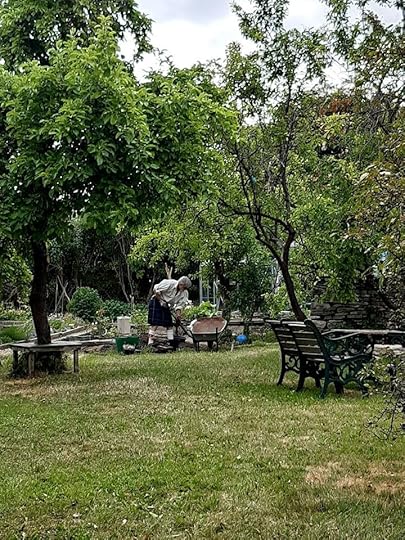 My Scottish husband Gordon, working in our Cotswold cottage garden in his kilt (as you do…)
My Scottish husband Gordon, working in our Cotswold cottage garden in his kilt (as you do…)Having married a Scot myself – and a Munro-bagger who led me on a 20-year tour of the Highlands (well, 20 years of summer holidays, anyway!) – I’ve seen more of the Highlands than many Scottish people, and I was delighted to have this chance to celebrate my love for their stunning scenery and distinctive culture.
 The fabulous Leakey’s bookshop is one of my favourite places in Inverness, and Murder in the Highlands includes a fictionalised version, which of course Hector adores
The fabulous Leakey’s bookshop is one of my favourite places in Inverness, and Murder in the Highlands includes a fictionalised version, which of course Hector adoresWhen I finished writing it, I felt as if I’d been back up there for a holiday myself, and I hope if you read Murder in the Highlands, you will also enjoy the journey.
 A fictionalised version of the Highland Folk Museum is the venue for a critical scene in the story
A fictionalised version of the Highland Folk Museum is the venue for a critical scene in the storyAlthough much of the novel takes place in Scotland, you’ll still have the chance to enjoy the company of your favourite characters from Wendlebury Barrow, as this novel starts and finishes on Hector’s home turf. At the start, the village grapevine suggests that Sophie and Hector will be travelling via Gretna Green, the ultimate romantic spot for eloping couples, for a secret wedding. Little does anyone know that Gretna will be the start of quite a different kind of adventure…
 I’m delighted with the use the designer has made of the HIghland cow on the book cover – on the print edition there’s a tiny one on the spine!
I’m delighted with the use the designer has made of the HIghland cow on the book cover – on the print edition there’s a tiny one on the spine!Murder in the Highlands will be launched on Wednesday 15th March in ebook, paperback, audiobook, hardback and large print, and should be available to order from anywhere you prefer to buy your books. If you have any problems tracking it down, just let me know and I’ll point you in the right direction.
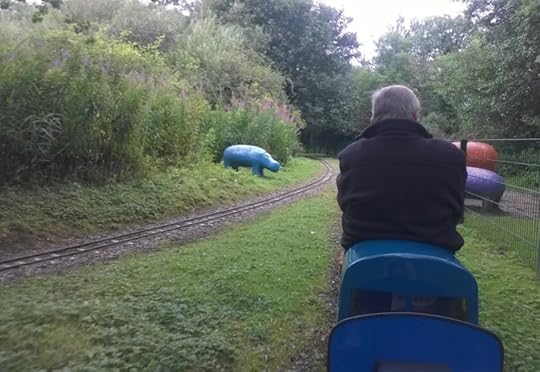 All in all, Sophie and Hector are in for a bumpy ride – and not only on the miniature train in Whin Park. Look out – hippos!
All in all, Sophie and Hector are in for a bumpy ride – and not only on the miniature train in Whin Park. Look out – hippos!There’s also an amazing blog tour lined up by Boldwood Books and Rachel’s Random Resources to get the new book off to a great start. Here’s the schedule of book bloggers if you’d like to follow it on its journey and check out what these seasoned reviewers are saying about Murder in the Highlands.
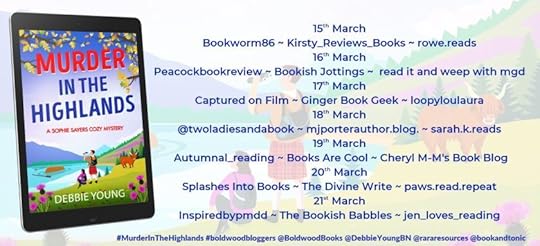
To sign up for Boldwood Books’ Debbie Young newsletter, which will keep you up to date with news, special offers and competitions to do with my Sophie Sayers and Gemma Lamb cozy mysteries, click here:
https://bit.ly/DebbieYoungNews
To join my Readers’ Club, which will send you a monthly newsletter about my writing life and general book news, plus a link for a free download to the exclusive novelette The Pride of Peacocks, click here:
NB You can do both – they complement each other rather than duplicating content.
March 8, 2023
My Ears Are Alight – and other Mondegreens
Decades ago, when I worked for a PR firm in an old banana warehouse in the shadow of Southwark Cathedral (but that’s another story), my colleague Rob was keen to improve his vocabulary.
Perhaps he was hooked on the old Readers’ Digest column, “It Pays to Increase Your Word Power”, a motto I’ve always admired. He designated a new word to learn every day, which he shared with us all. I worked alongside him for only a few months, but if I’d shared his office for the rest of my career, I reckon he’d have increased my word power too by around 10,000 words.
If we were still in touch, I’d love to share with him the latest new word I’ve learned: mondegreen.
No, it’s not lifted from the Farrow and Ball paint chart, although it does make me picture the colour of fern leaves. Instead, it refers to the phenomenon of mishearing a phrase which you then repeat in its distorted form.
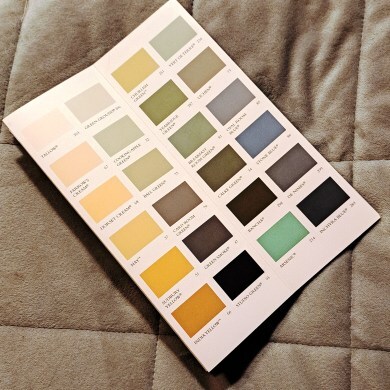
The mondegreen is a cousin of Chinese whispers, of which my favourite example is my Uncle Peter’s apocryphal story: in the army, the message “Send reinforcements, we’re going to advance” turns into “Send three-and-fourpence, we’re going to a dance”. (The reference to shillings and pence dates it.)
When the brain can’t make sense of a phrase, it creates its own meaningful version.
Thanks to the US national anthem, many Americans think “donzerley” is a word, as in “Oh, say, can you see by the dawn’s early light?” Others think the song is addressed to a fellow called José – “José, can you see…”. It makes me picture Donald Trump taunting Mexicans from the top of his proposed border wall.
Another classic occurs in the 1960s reggae hit, “The Israelites”, in which singer Desmond Dekker enunciates every syllable of the refrain “Poor me Israelites”. Once you’ve heard “My ears are alight”, you can never unhear it.
My favourite mondegreen was of my daughter Laura’s making. Aged five when the first ABBA movie was released, she put on her sixth birthday wish list “something Mamma Mia!-ish”. We bought her a sugar-pink iPod Shuffle preloaded with the soundtrack.
She was a teenager before the realised that in Super Trouper, Anni-Frid is not singing “I was sick and tired of everything when I called you last night from Tesco”, but from “Glasgow”. Now I can’t help but picture poor Anni-Frid pushing her trolley wearily round the supermarket in between gigs.
My colleague Rob would have wanted to know the origin of the word mondegreen. Although a concept as old as song itself, the phrase was coined in 1954 by American writer Sylvia Wright after realising that as a child she’d misheard a line in a Scottish ballad recited to her by her mother:
They hae slain the Earl o’Morley
And laid him on the green.
In her young mind, she’d pictured a double murder – of not only the Earl but also his companion Lady Mondegreen. That makes perfect sense to me.
This post was first published in the March 2023 edition of the Tetbury Advertiser.
FOR OTHER MONDEGREENS & OTHER FUN WITH WORDS, VISIT THE HULF FESTIVAL OF WORDS (22ND April 2023)If you would like to hear more mondegreens and enjoy entertaining talks about many other aspects of the English language, come along to our next HULF Talk on Saturday 22nd April at St Mary’s Church Hawkesbury in collaboration with the Friends of St Mary’s, I’ll be directing a Hawkesbury Upton Literature Festival (HULF) Talk Festival of Words. More information including ticket booking here: www.hulitfest.com,
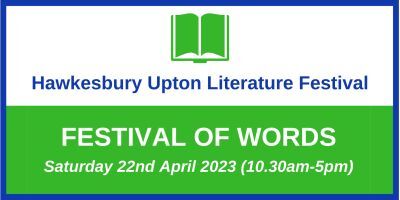
 ISIS Audio, is the Oxford-based recording studio that makes audiobooks for my publisher Boldwood Books and for Ulverscroft, the aspecialist in making books more accessible, reaching a wider audience than is possible with print and ebooks alone. On its website, Ulverscroft describes itself as follows:
ISIS Audio, is the Oxford-based recording studio that makes audiobooks for my publisher Boldwood Books and for Ulverscroft, the aspecialist in making books more accessible, reaching a wider audience than is possible with print and ebooks alone. On its website, Ulverscroft describes itself as follows:
“The Ulverscroft Group was founded in 1964 with one aim: to bring back the joy of reading to those who had thought it was no longer possible.”
These days, audiobooks aren’t just for those with visual impairment, and I’m not averse to reading a large-print book myself when my eyes are tired, even though I’m still comfortable reading without glasses.
I think all three of these organisations do a terrific job in sharing my stories around the world, and I was very pleased to be asked to provide an interview for ISIS, which they shared on social media via this image:
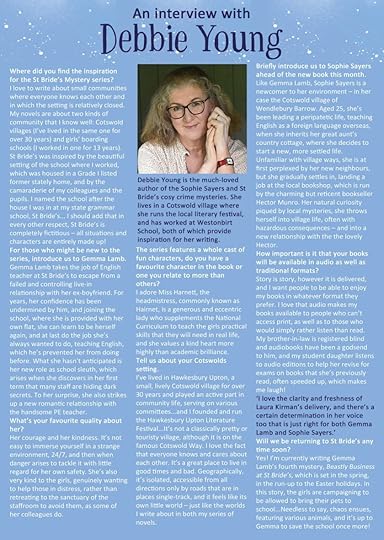
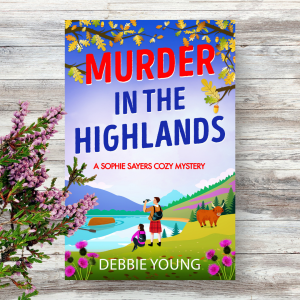 Now available to pre-order
Now available to pre-orderMy latest novel, Murder in the Highlands, the eighth Sophie Sayers mystery, will be published on 15 March by Boldwood Books in ebook, paperback, hardback, large print and audiobook.
Pre-order the ebook online here!
This story starts and finishes in Sophie’s Cotswold village of Wendlebury Barrow, and in between times she whisks Hector up to Inverness to meet her parents, planning a pleasant holiday. But as they cross the border to Gretna Green, trouble is right behind them, resulting in a murderous pursuit across the beautiful Scottish Highlands!
This book is a celebration of my love for the Scottish Highlands, and I hope that by the time you’ve finished reading it, you’l feel as if you’ve had a Scottish holiday too!
You can already pre-order the ebook, and the other editions including paperback and audiobook will be available to order on launch day online and from bookshops.
As always, if you have any problems tracking down a copy in your chosen format, just contact me via the form on this website.
March 1, 2023
Why Every Day Should Be a Book Day
As anyone with a school-age child cannot fail to be aware, Thursday 2nd March will be World Book Day. This annual event was founded by UNESCO to promote reading. While almost all schools do something special to celebrate books that day, they work hard to foster a love of reading all year round, and quite right too.
Having spent three years working for Read for Good, the national children’s reading charity based in Nailsworth, I’m well versed in the life-long advantages gained by children who habitually read for pleasure:
greater academic achievementmore successful careersa broader vocabularybetter social skillsstronger interpersonal relationships and more…All reading expands the reader’s experience of life, and the older I get, the more I want to squeeze into mine.
Yet in our busy adult lives, it’s easy to forget that a leisure reading habit benefits us in the same ways.
So this World Book Day, take a leaf out of the children’s books (ho ho) and treat yourself to some quality reading time.
When I say quality, don’t worry, I’m not asking you pick up Proust or delve into Dickens. Just read what you enjoy.
There really is no such thing as a bad book.
I’m sure Prince Harry would be glad to hear me say that.
You don’t have to wait till your summer holidays to enjoy a beach read. Conversely, if you fancy the challenge of a demanding 1000-page classic, treat yourself to the time it takes to complete it.
Don’t feel guilty if you’d rather reread an old favourite than tackle something new. Novelist Ali Smith provides the perfect justification. She says every rereading provides a different experience, because you’ll have changed as a person in between times.
A book is not just about what the author writes – it’s about what the reader brings to it too.
That makes perfect sense to me. When I first read Through the Looking Glass as a child, I identified entirely with Alice. Now I feel (and look) more like the White Queen.
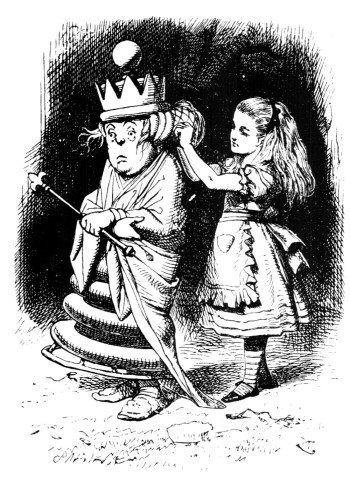 (John Tenniel’s drawing from Through the Looking Glass is in the public domain)
(John Tenniel’s drawing from Through the Looking Glass is in the public domain)Of course, for adults, dressing up as their favourite book character for World Book Day is strictly optional, although if the Seasalt catalogue counts as a book, that works for me.
This post was first published in the March 2023 edition of the Hawkesbury Parish News,
IN OTHER NEWSSPECIAL EBOOK DEAL ON BEST MURDER IN SHOW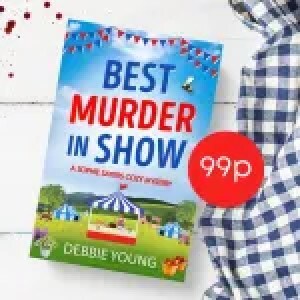 For a limited time only!
For a limited time only!For a short time only, the first in my Sophie Sayers Village Mystery series will be just 99p/99c in the UK, Canada and Australia, thanks to my publishers Boldwood Books securing a special featured deal with book promoters Bookbub.
Download your 99p/99c ebook here!
If you haven’t read it yet, this is the book that sets the scene for the ever-growing series of comedy mystery novels set in a fictitious Cotswold village inspired by the one where I’ve lived for the last 32 years. It’s full of fun and humour, with a cast of lovable eccentrics and villains you’ll love to hate.
As it’s a cosy (cozy) mystery, its light, gentle, and family friendly, with nothing to give you (or me!) nightmares. This story is set at the height of summer and revolves around the annual village show – the social highlight for many traditional English villages, my own included.
(Apologies to readers in other countries that the offer doesn’t apply to you – that’s not my choice!)
LAUNCHING ON 15th MARCH Now available to pre-order
Now available to pre-orderMy latest novel, Murder in the Highlands, the eighth Sophie Sayers mystery, will be published on 15 March by Boldwood Books in ebook, paperback, hardback, large print and audiobook.
Pre-order the ebook online here!
This story starts and finishes in Sophie’s Cotswold village of Wendlebury Barrow, and in between times she whisks Hector up to Inverness to meet her parents, planning a pleasant holiday. But as they cross the border to Gretna Green, trouble is right behind them, resulting in a murderous pursuit across the beautiful Scottish Highlands!
This book is a celebration of my love for the Scottish Highlands, and I hope that by the time you’ve finished reading it, you’l feel as if you’ve had a Scottish holiday too!
You can already pre-order the ebook, and the other editions will be available to order on launch day online and from bookshops.
As always, if you have any problems tracking down a copy in your chosen format, just contact me via the form on this website.

